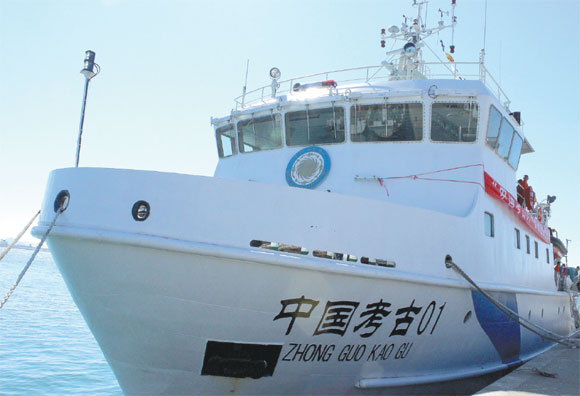Into the deep
Updated: 2014-09-16 09:10
By Wang Kaihao(China Daily USA)
|
||||||||
The country's first underwater archaeological vessel is set to comb the nation's coastline in search of long-lost cultural relics. Wang Kaihao reports in Qingdao, Shandong province.
China's first underwater archaeological vessel, China Archeology No 1, made its maiden voyage on Sept 4 in Qingdao, Shandong province. The vessel will explore the country's 18,000-kilometer-long coastline in search of sunken cultural relics and shipwrecks.
The 57.9-meter-long and 10.8-meter-wide boat with a displacement of 980 tons is powered by electricity. It was manufactured in Chongqing by China Shipbuilding Industry Corp at a cost of 60 million yuan ($9.77 million). It is able to cruise over 1,000 nautical miles at any one time and work nonstop for a month.
"Historically, Chinese sea archeology relied on rented fishing boats to carry out underwater research work," Chai Xiaoming, director of the Beijing-based National Center of Underwater Cultural Heritage, said during the boat's inaugural ceremony.
The working conditions on fishing boats were poor, he said, and "the noise from the motor made it difficult to use the sonar detecting system. They were also too fragile in strong winds."
Li Shuicai, chief engineer of the design team behind China Archeology No 1, says the ship is equipped with multiple special devices to better serve aquanauts, detect and salvage wrecks, and repair cultural relics. Underwater archeological robots will be installed in the future.
China Archeology No 1 will still need to cooperate with other larger vessels when undertaking big projects, but it will act as "the flagship in an archeological fleet", says Chai.
"It's not only a ship, but also a comprehensive platform to conduct research on the sea. It can also function as a small museum to better inform the public when we are not out at sea."
According to Chai, only a few other countries, such as France, South Korea and Greece, have professional underwater archeological vessels.
The ship's first assignment is being carried out near the port of Dandong in Liaoning province. Chai refused to reveal the details of the mission.
He says around 200 cultural heritage sites have been discovered along China's coasts, and his team plans to draw a map pinpointing each of the sites.
The National Center of Underwater Cultural Heritage became affiliated to the State Administration of Cultural Heritage in August to better coordinate and manage China's underwater archeological exploration.
The new center will act as a liaison between multiple departments, including the State Oceanic Administration and public safety authorities, to halt crimes such as the smuggling of cultural relics.
"We will not be able to achieve much without having a specific team focused on underwater work," says Li Xiaojie, director of the State Administration of Cultural Heritage. "The exploration of ocean resources means more than just the development of a maritime economy. It also serves a wider range of public interests."
Qingdao is the first base of the center, and its headquarters are in Beijing. Bases will also be built in other regions, including Zhejiang province's Ningbo, Hubei's provincial capital Wuhan and the Xisha Islands.
"The security situation has not been ideal," Li says, adding that relics have been illegally extracted from shallow areas of the South China Sea along the country's coast.
"Complicated disputes on maritime interests with neighboring countries have also given us pressure. Maritime archeology is more closely connected with overseas countries than other fields. To ensure our national interests, we will gradually promote cross-border cooperation, starting with academic studies and training programs."
China recently completed a three-year cooperative underwater archeology discovery quest with Kenya near the Kenyan city Malindi, working alongside the country's first professional underwater archeologist squad.
Li says the State Administration of Cultural Heritage will be more active in international projects under the framework of UNESCO. After the Silk Road and Grand Canal were listed as UNESCO World Heritage sites in June, China formally launched a bid to have the Maritime Silk Road - a historical trade and cultural corridor in the sea connecting the East and West that peaked during the Song (960-1279) and Yuan (1271-1368) dynasties - placed on the list.
Many ancient ships with treasures are buried along the corridor. "The enhancement of underwater archeological discovery is one of the keys to having the corridor listed as a World Heritage site," says Xie Xiuzhi, director of the Shandong Provincial Administration of Cultural Heritage.
The official application, which involves seven provincial-level administrative regions, will be submitted to UNESCO in 2016.
Li Xiaojie says China's underwater archeology lacks clear supervision, and "more rigid and timely regulation is a must".
"The rule of law offers the fundamental support to preserving the cultural relics," Li says.
Contact the writer at wangkaihao@chinadaily.com.cn
|
China's first underwater research vessel, China Archeology No 1, anchors in Qingdao, Shandong province. Wang Kaihao / China Daily |
|
An archeologist cleans items of porcelain fromNan'ao One. Xinhua |
(China Daily USA 09/16/2014 page8)

 Star Stefanie Sun holds concert in Beijing
Star Stefanie Sun holds concert in Beijing
 Faye Wong's manager refutes star's drug rumors
Faye Wong's manager refutes star's drug rumors
 Lu Yi and daughter Bei Er pose for street snaps
Lu Yi and daughter Bei Er pose for street snaps
 Photoshoots of actress Li Xiaomeng
Photoshoots of actress Li Xiaomeng
 Council of Fashion Designers of America Awards
Council of Fashion Designers of America Awards
 Fan Bingbing, first Chinese actress in Barbie Hall of Fame
Fan Bingbing, first Chinese actress in Barbie Hall of Fame
 Awarding ceremony of 2014 hito Pop Music held in Taipei
Awarding ceremony of 2014 hito Pop Music held in Taipei
 Zhao Liying's photo shoot for Children's Day
Zhao Liying's photo shoot for Children's Day
Most Viewed
Editor's Picks

|

|

|

|

|

|
Today's Top News
Improved quality 'key to growth', says Li
IMF assesses risks and benefits of shadow banking
Apple Pay eyes inroads to China
Sinopec privatization biggest in Xi's tenure
Beijing to tighten foreign hiring requirements
Hillary Clinton takes a big step toward 2016
US teachers visit China on fellowship
More CFAs buoy hopes for finance
US Weekly

|

|










